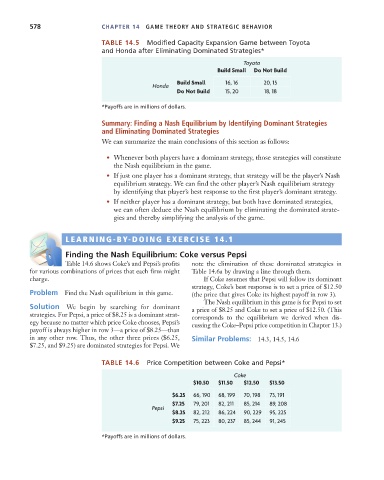Page 604 - Microeconomics, Fourth Edition
P. 604
c14gametheoryandstrategicbehavior.qxd 8/6/10 11:56 AM Page 578
578 CHAPTER 14 GAME THEORY AND STRATEGIC BEHAVIOR
TABLE 14.5 Modified Capacity Expansion Game between Toyota
and Honda after Eliminating Dominated Strategies*
Toyota
Build Small Do Not Build
Honda Build Small 16, 16 20, 15
Do Not Build 15, 20 18, 18
*Payoffs are in millions of dollars.
Summary: Finding a Nash Equilibrium by Identifying Dominant Strategies
and Eliminating Dominated Strategies
We can summarize the main conclusions of this section as follows:
• Whenever both players have a dominant strategy, those strategies will constitute
the Nash equilibrium in the game.
• If just one player has a dominant strategy, that strategy will be the player’s Nash
equilibrium strategy. We can find the other player’s Nash equilibrium strategy
by identifying that player’s best response to the first player’s dominant strategy.
• If neither player has a dominant strategy, but both have dominated strategies,
we can often deduce the Nash equilibrium by eliminating the dominated strate-
gies and thereby simplifying the analysis of the game.
LEARNING-BY-DOING EXERCISE 14.1
S
D
E
Finding the Nash Equilibrium: Coke versus Pepsi
Table 14.6 shows Coke’s and Pepsi’s profits note the elimination of these dominated strategies in
for various combinations of prices that each firm might Table 14.6a by drawing a line through them.
charge. If Coke assumes that Pepsi will follow its dominant
strategy, Coke’s best response is to set a price of $12.50
Problem Find the Nash equilibrium in this game. (the price that gives Coke its highest payoff in row 3).
The Nash equilibrium in this game is for Pepsi to set
Solution We begin by searching for dominant a price of $8.25 and Coke to set a price of $12.50. (This
strategies. For Pepsi, a price of $8.25 is a dominant strat- corresponds to the equilibrium we derived when dis-
egy because no matter which price Coke chooses, Pepsi’s cussing the Coke–Pepsi price competition in Chapter 13.)
payoff is always higher in row 3—a price of $8.25—than
in any other row. Thus, the other three prices ($6.25, Similar Problems: 14.3, 14.5, 14.6
$7.25, and $9.25) are dominated strategies for Pepsi. We
TABLE 14.6 Price Competition between Coke and Pepsi*
Coke
$10.50 $11.50 $12.50 $13.50
$6.25 66, 190 68, 199 70, 198 73, 191
$7.25 79, 201 82, 211 85, 214 89, 208
Pepsi
$8.25 82, 212 86, 224 90, 229 95, 225
$9.25 75, 223 80, 237 85, 244 91, 245
*Payoffs are in millions of dollars.

